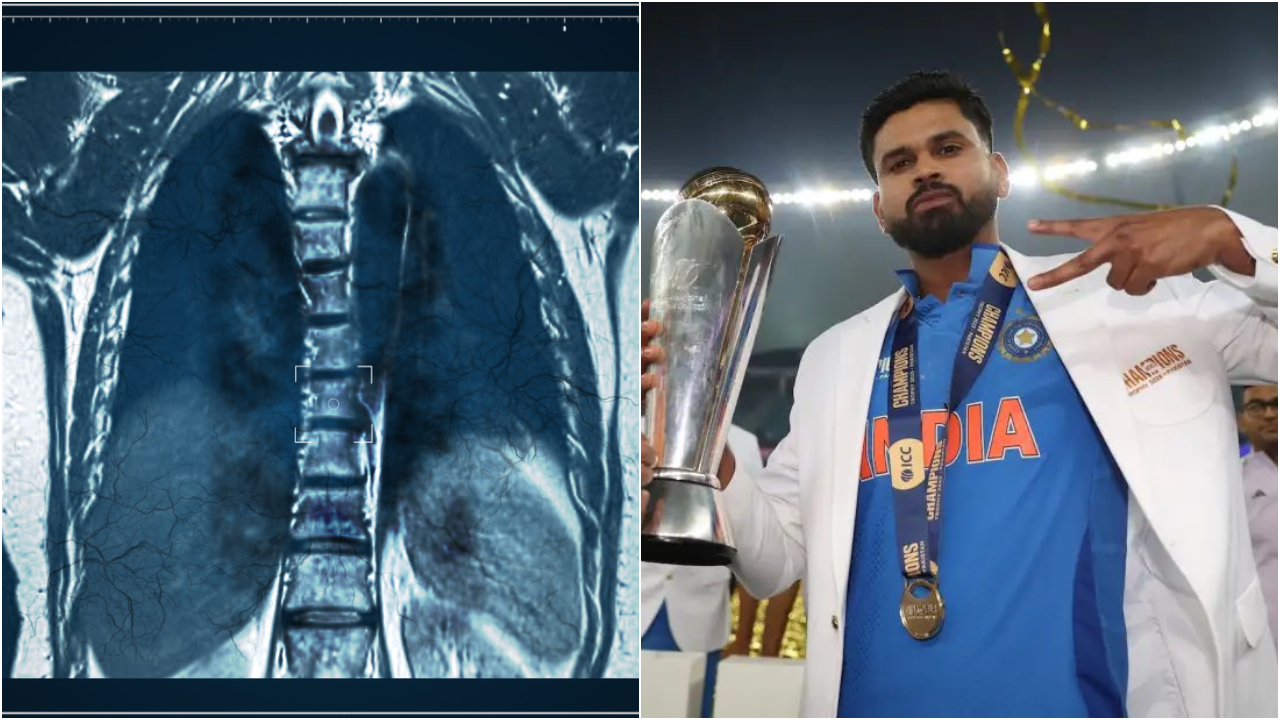With access to advanced imaging and interventional care, most blunt injuries today can be managed effectively if caught in time.
Published Oct 30, 2025 | 2:45 PM ⚊ Updated Oct 30, 2025 | 2:45 PM

In Shreyas Iyer’s case, early diagnosis meant doctors could manage the injury conservatively, without surgery. Credit: iStock, x.com/ShreyasIyer15
Synopsis: Shreyas Iyer’s spleen laceration from a blunt abdominal hit in Sydney ODI highlights hidden dangers in sports. Dr. Sonal Asthana explains: no visible wound, but liver/spleen tears cause severe internal bleeding, shock. CT scan diagnoses; interventional radiology often avoids surgery. Athletes must heed disproportionate pain—early detection key; six-week rest typical for recovery.
When Indian batter Shreyas Iyer suffered a blunt abdominal injury leading to a spleen laceration and internal bleeding during the third ODI against Australia in Sydney, it drew attention to a kind of trauma that is not uncommon among athletes but is often poorly understood outside medical circles.
Iyer’s case, now under close observation by BCCI doctors and specialists in India and Australia, highlights why blunt injuries, though they may show no visible wound, can be serious and require immediate medical care.
To explain the medical side of such trauma, Dr. Sonal Asthana, clinical lead and program director, Aster Integrated Liver Care, Aster Group of Hospitals, Bengaluru, shares insights drawn from his experience in managing abdominal trauma cases, to South First.
Blunt abdominal injuries occur when an external force impacts the body hard enough to damage internal organs, but without breaking the skin.
“The abdomen houses sensitive organs such as the liver, spleen, and intestines,” explained Dr. Asthana. “Even when the skin remains intact, these internal structures can suffer significant trauma.”
Unlike penetrating injuries caused by sharp objects, blunt injuries are the result of pressure or collision, such as those seen in road traffic accidents or contact sports.
“In sports with physical contact, or even where falls are common, it’s possible to sustain a blunt injury without realising the extent immediately,” he said.
When such an impact occurs, the immediate concern is whether the internal organs have been damaged.
“The first red flag is pain that seems disproportionate to the visible injury,” said Dr. Asthana and added that, If someone complains of severe discomfort even though there’s no external bruise or cut, doctors suspect internal bleeding or organ injury.
Since the liver and spleen are highly vascular organs, even a small tear can cause serious internal bleeding. These organs handle large volumes of blood every minute. So, when they are injured, the patient may quickly go into low blood pressure or hypovolemic shock due to blood loss, he said.
Asthana described the process of diagnosing and managing blunt abdominal injuries as a race against time, where stabilising the patient and identifying internal damage must happen almost simultaneously.
Once doctors suspect internal bleeding, the first step is to check the patient’s pulse and blood pressure to rule out shock.
Imaging is done right after, and Dr Asthana said a CT scan of the abdomen is the most dependable way to confirm where and how badly an organ is injured.
“It not only helps identify which organ is injured, but also reveals whether there’s any leakage or perforation that needs urgent attention,” he explained.
Treatment decisions, he noted, depend entirely on the severity of the injury. In the past, surgery was often unavoidable, sometimes even involving removal of the spleen to stop internal bleeding. But medical advancements have made that approach less common.
Asthana pointed out that interventional radiology now allows doctors to reach the bleeding vessel through minimally invasive, angiogram-like procedures and block it without open surgery.
Recovery timelines, too, vary widely according to the intensity. Minor injuries can heal naturally with proper rest, while major ones that cause heavy bleeding or organ rupture still require surgical repair.
“Athletes are generally advised at least six weeks of complete rest so the organ can heal and clot formation can stabilise,” he said.
For athletes, especially those in contact or high-intensity sports like cricket, football, or rugby, the risk of a blunt abdominal injury is part of the game.
Even in non-contact sports, a sudden fall, collision, or awkward landing can trigger similar internal trauma. Such incidents, while seemingly minor, can sometimes lead to hidden bleeding or organ damage that doesn’t show up immediately.
According to Asthana, awareness of these possibilities is just as vital as physical fitness. Internal injuries of this kind are often underestimated precisely because they leave no visible mark.
Players may assume it’s just a muscle strain and continue to train or play through the pain. But slow internal bleeding can continue unnoticed, worsening the situation before medical help is sought.
The safest approach, Asthana explained, is to treat any persistent or disproportionate pain after a fall or hit with urgency.
If symptoms such as dizziness, weakness, or deep abdominal discomfort appear, immediate evaluation is crucial.
“Delays in diagnosis can lead to serious complications, including shock,” he warned. “Early detection is what saves lives in these cases.”
Fortunately, with access to advanced imaging and interventional care, most blunt injuries today can be managed effectively if caught in time.
In Shreyas Iyer’s case, early diagnosis meant doctors could manage the injury conservatively, without surgery, an outcome Asthana described as “the ideal scenario,” where prompt medical attention prevents escalation and ensures a safe return to sport.
(Edited by Amit Vasudev)
